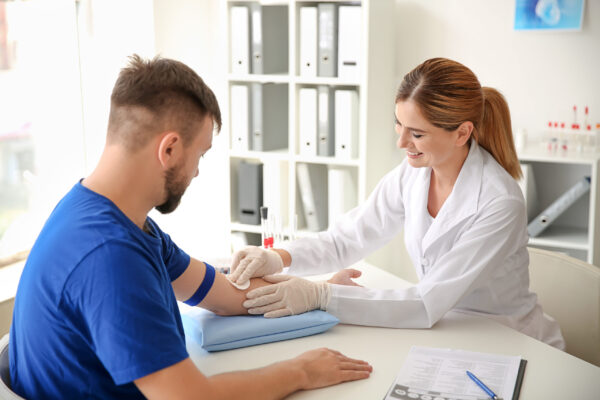ON-SITE PHLEBOTOMY
Our clinic in Washington DC offers on-site phlebotomy services for your convenience.

Through our partnership with LabCorp, Washington Health Institute is proud to offer on-site phlebotomy services for your convenience. Lab hours are Monday through Friday from 8:00AM to 4:30PM. Walk-ins are welcome. We accept the last walk-in for the day at 3:30PM.
WHAT IS PHLEBOTOMY?
Phlebotomy is when a medical professional uses a needle to take a sample of your blood, usually from a vein in your arm. This blood test is an essential tool in the diagnosis of many medical conditions, including HIV/AIDS and other infectious diseases. After the blood test, your sample will be sent over to LabCorp to analyze and determine your results.
WHAT TO EXPECT DURING A BLOOD TEST
In most cases, you will not have to prepare in any way prior to your blood test. This is why walk-ins are generally acceptable. If your test does require any additional preparation, such as fasting for a certain amount of time prior to the test, your doctor will give you these instructions before you arrive.
When you arrive at our lab, your technician will have you sit or lie down and then make a fist with your hand. At this point, the person taking your blood will tie a small band, called a tourniquet, around your upper arm to help make the veins more visible and make it easier to insert the needle into the correct spot.
Patients may feel a small pinch or sting when the needle is inserted. This is normal and is not a cause for concern. The needle will be attached to a small tube that connects to a test tube or bag for the blood to flow into. If you’re having blood drawn for tests, you may need to fill one or more test tubes. This entire process should only take a few minutes.
Once the lab has enough of a sample, the nurse or technician will remove the needle from your arm, release the tourniquet and provide you with a bandage for the affected area. You may be asked to press down gently on the spot with gauze for a few minutes until the bleeding fully stops. This bandage may be worn for up to a few hours to ensure the spot is no longer bleeding.
For more information about Washington Health Institute’s partnership with LabCorp or our on-site phlebotomy services, call our office at 202-525-5175 or schedule an appointment online.
INSTRUCTIONS FOR YOUR BLOOD TEST
Before you have your blood drawn, it’s important to know if a patient needs to follow any special instructions before the test. For example, some tests require that you don’t eat and/or drink for a certain amount of time. Other tests don’t require you to fast at all. Please follow the instructions provided to you.
If you don’t have any special instructions other than an arrival time, there are still some steps you can take to try to make this process easier:
- Drink plenty of water before your appointment. When you’re hydrated, your blood volume goes up, and your veins are plumper and easier to access.
- Eat a healthy meal before you go. Choosing one with plenty of protein and whole-grain carbohydrates may prevent you from feeling light-headed after giving blood.
- Wear a short-sleeved shirt or layers. This makes accessing your veins easier.
- Stop taking aspirin at least two days before your blood draw if you’re donating platelets.
- You may wish to mention if you have a preferred arm for a person to draw blood from. This could be your nondominant arm or an area where you know a person taking your blood has had success before.
AFTER YOUR BLOOD TEST
After the blood draw is finished, your phlebotomist will remove the needle, hold gauze against the puncture site, and ask you to apply pressure. Applying pressure can help reduce bruising. However, some bruising is a normal side effect of phlebotomy.
Even with these precautions, minor bruising and swelling around the puncture site can occur. Because every person’s veins are different, bruising can occur even with the most experienced phlebotomists. If you do bruise, it should go away within a few days.
